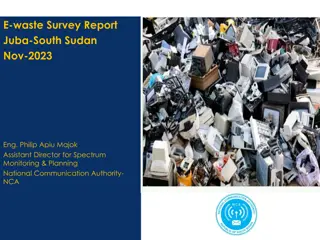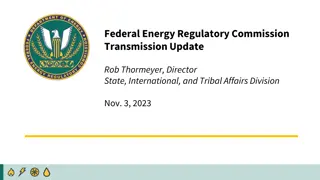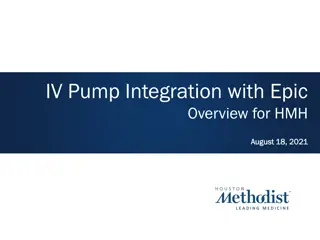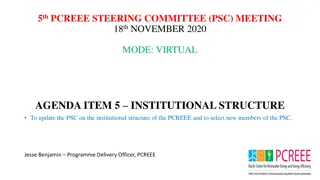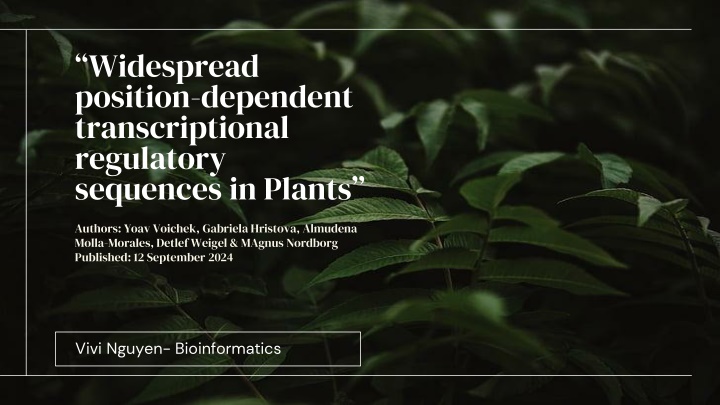
Investigating Position-Dependent Transcriptional Regulatory Sequences in Plants
Explore the research on position-dependent enhancers in plants, focusing on sequences downstream of the TSS and their impact on gene expression. Learn about eQTL analysis findings, chromatic and TF involvement, and the unique transcriptional regulation in plants compared to animals.
Download Presentation

Please find below an Image/Link to download the presentation.
The content on the website is provided AS IS for your information and personal use only. It may not be sold, licensed, or shared on other websites without obtaining consent from the author. If you encounter any issues during the download, it is possible that the publisher has removed the file from their server.
You are allowed to download the files provided on this website for personal or commercial use, subject to the condition that they are used lawfully. All files are the property of their respective owners.
The content on the website is provided AS IS for your information and personal use only. It may not be sold, licensed, or shared on other websites without obtaining consent from the author.
E N D
Presentation Transcript
Widespread position-dependent transcriptional regulatory sequences in Plants Authors: Yoav Voichek, Gabriela Hristova, Almudena Molla-Morales, Detlef Weigel & MAgnus Nordborg Published: 12 September 2024 Vivi Nguyen- Bioinformatics
-Purpose- This research investigates these position-dependent enhancers, focusing specifically on the sequences downstream of the TSS, and explores how they influence gene expression across multiple plant species As well as grasping properties of cis-regulatory sequences in plants, using massively parallel reporter assays (MPRAs) to map the roles of these sequences
Key Points of this Study 01 02 03 GATC Motif as Key Regulatory Player Plant Enhancers are Position-Dependent Intro to eQTL 04 05 06 Future Outlook & Limitations Cross- Species Consistency Regulation Downstream of the TSS
Introducing eQTL eQTL (expression Quantitative Trait Loci): Genomic regions where genetic variation affects gene expression. Helps identify regulatory elements influencing gene activity. On or Off gene What is it? Key Finding from Research Downstream eQTL highlight unique transcriptional regulation in plants, distinct from animals.
Arabidopsis eQTL Analysis Findings Chromatic & TF Involvement eQTL Enrichment Found a similar proportion of eQTL downstream of the TSS as upstream, challenging the traditional assumption that most regulatory elements are upstream. Downstream eQTL regions were associated with histone enrichment (e.g., H3.1 and H3.3) and TF binding sites, confirming their role in transcription regulation. mRNA Stability vs Transcription Regulation Conserved Pattern Across Data Sets The enrichment of eQTL downstream of the TSS was consistent across multiple Arabidopsis gene expression datasets. Unlike in humans, where eQTL often correspond to mRNA stability regions, in Arabidopsis, eQTL downstream of the TSS appear to regulate transcription directly rather than mRNA stability.
eQTL enrichment found downstream of TSS
mRNA Stability vs Transcription Regulation [Hypothesis] If eQTL variants affect mRNA stability, they should be more frequent in exons than introns, as introns are removed by splicing. Unlike human eQTL, Arabidopsis eQTL showed no preference for exons over introns.
mRNA Stability vs Transcription Regulation eQTL were more frequent: Just downstream of the TSS for genes with longer TSS-to- ATG distances (including 5 UTRs and introns). Just upstream of the TSS for genes with shorter TSS-to-ATG distances.
Chromatic & TF Involvement In Vivo Immunoprecipitation DNA Affinity Purification Seq, In Vitro
Massively Parallel Reporter Assay (MPRA) Designed 12,000 160-bp DNA fragments from upstream and downstream regions of Arabidopsis transcription start sites (TSS). Inserted fragments into reporter constructs with GFP genes for expression analysis. Analyzed transcriptional activity using RNA sequencing across four plant species: Arabidopsis, tomato, maize, and Nicotiana benthamiana.
Continuation of MPRA.. 2 different GFP reporter constructs utilized 46-bp Cauliflower Mosaic Virus (CaMV) 35s minimal promoter + short synthetic 5 UTR 700-bp Arabidopsis TRP1 including its 5 UTR Study the effect of introns on gene expressions
Continuation of MPRA *Reproducibility was made sure throughout 3-4 repeated experiments
Role of IUB Q10 Enhancers in Results Intronic sequences from the UBQ10 gene. Used as control to confirm the position-dependent of the plant Fragments derived from IUBQ10 introns enhanced transcription more effectively when placed downstream of the TSS (inside the intron of the GFP reporter gene). These sequences were less effective when positioned upstream, supporting the idea that intronic enhancers in plants are position-dependent.
Position Dependent Enhancer Activity Enhancer fragments showed similar activity across species, promoters, and host cell introduction methods.
Impact of Original Genomic Location on Activity In maize, fragments placed upstream often reduced reporter expression, regardless of their genomic origin. Despite variations in absolute expression levels due to backbone or species, the relative activity of fragments at the same position was consistent across species.
Validation Techniques Mutation and Position Analysis Compared transcription rates via mRNA synthesis assays. Tested fragment effects across different promoters, species, and transformation methods. Systematic modification of fragments to assess transcriptional effects. GATC motifs identified and studied for their role in enhancing transcription.
Introducing GATC Motif GATC motif identified as a key regulatory element. i. GATC is the core motif, often embedded in larger sequences (e.g., YVGATCBR, where Y = C/T, V = A/C/G, B = C/G/T, R = A/G). Enhancers with GATC motifs downstream of the TSS increased gene expression in a dose-dependent manner. i. The more GATC motifs present in a downstream region, the stronger the transcriptional enhancement.
More 6-mers were associated with promoting expression than repressing it when located downstream of the TSS. These 6-mers likely represent binding sites for TFs that regulate transcription in downstream regions.
GATC Motif Effects Synthesized 18,000 additional oligonucleotides, each a variant of fragments from the initial pool, and inserted them downstream of the TSS in two backbones. Deleted, shuffled, or mutated the core GATC sequence to GATA.
Focused on 841 fragments containing a GATC motif. Removing or altering the GATC motif caused an average 50% reduction in gene expression, irrespective of mutation type.
Deep Mutational Scan Conducted deep mutational scans on 13 downstream- derived fragments, generating 736 derivatives per fragment by: 1. Deleting sets of ten consecutive base pairs. Mutating each nucleotide to its three alternatives or deleting it. 2. Altering the core 4 bp of the GATC motif consistently decreased activity, emphasizing strict sequence constraints.
Testing GATC Sufficiency Selected 221 fragments (166 downstream-derived, 55 upstream- derived) and incrementally added 1 8 GATC motifs. Expression increased with each added GATC motif, even in upstream-derived fragments. Observations 97% of fragments enhanced expression when at least 4 GATC motifs were added. Highly active fragments saturated after one addition, while low-activity fragments remained unsaturated even after eight.
Natural Variation Analysis GATC motifs downstream of the TSS, particularly within 500 bp, correlated with higher gene expression. Consistent with synthetic MPRA results, highlighting the motif's role in transcriptional enhancement.
GATC Motifs Transcription Across Tissues Findings moved from leaf cells to GATC s impact on other tissues & stages GATC motif activity fluctuate threefold across tissues and stages Lowest effects was seen in seed developmental stages Strongest effects observed in roots , in the meristem zone
Limitations from this Study 1 2 3 TSS still remain unclear Plant-specific genome packing Primarily leaf cells, limited on tissues & stages 4 5 Non-GATC sequences Vascular (fern) vs Nonvascular (mosses) Plants
-Future Outlook on this Research- Evolutionary Insights Mechanistic Studies We can explore more how downstream regulatory mechanisms and motifs like GATC evolved across plant lineages Investigate how plant-specific genome architecture influences regulatory element function near the TSS Broader Applications Unanswered Questions Determine the precise roles of GATC motifs in different tissues and environmental conditions Utilize GATC motif insights for crop improvement by engineering gene expression patterns in agricultural species
Thank You :) REferences-_ 1.Voichek, Y., Hristova, G., Moll -Morales, A. et al. Widespread position- dependent transcriptional regulatory sequences in plants. Nat Genet56, 2238 2246 (2024). https://doi.org/10.1038/s41588-024-01907-3 2. Gallegos, J. E. & Rose, A. B. An intron-derived motif strongly increases gene expression from transcribed sequences through a splicing independent mechanism in Arabidopsis thaliana. Sci. Rep. 9, 13777 (2019).





